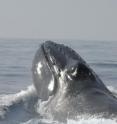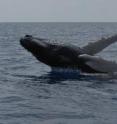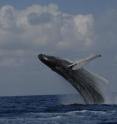Genetic study pursues elusive goal: How many humpbacks existed before whaling?
Related images
(click to enlarge)
Scientists from Stanford University, the Wildlife Conservation Society, the American Museum of Natural History, and other organizations are closing in on the answer to an important conservation question: how many humpback whales once existed in the North Atlantic? Building on previous genetic analyses to estimate the pre-whaling population of North Atlantic humpback whales, the research team has found that humpbacks used to exist in numbers of more than 100,000 individuals. The new, more accurate estimate is lower than previously calculated but still two to three times higher than pre-whaling estimates based on catch data from whaling records.
Known for its distinctively long pectoral fins, acrobatics, and haunting songs, the humpback whale occurs in all the world's oceans. Current estimates for humpback whale numbers are widely debated, but some have called for the level of their international protection to be dropped.
The study appears in the recently published edition of Conservation Genetics. The authors include: Kristen Ruegg and Stephen Palumbi of Stanford University; Howard C. Rosenbaum of the Wildlife Conservation Society and the American Museum of Natural History; Eric C. Anderson of the National Marine Fisheries Service and University of California-Santa Cruz; Marcia Engel of the Instituto Baleia Jubarte/Humpback Whale Institute, Brazil; Anna Rothschild of AMNH's Sackler Institute for Comparative Genomics; and C. Scott Baker of Oregon State University.
"We're certain that humpback whales in the North Atlantic have significantly recovered from commercial whaling over the past several decades of protection, but without an accurate size estimate of the pre-whaling population, the threshold of recovery remains unknown," said Dr. Kristen Ruegg of Stanford University and the lead author of the study. "We now have a solid, genetically generated estimate upon which future work on this important issue can be based."
"Our current challenge is to explain the remaining discrepancy between the historical catch data and the population estimate generated by genetic analyses," said Dr. Howard Rosenbaum, study co-author and Director of the Wildlife Conservation Society's Ocean Giants Program. "The gap highlights the need for continued evaluations of whale populations, and presents new information informing the debate and challenges associated with recovery goals."
"We have spent a great deal of effort refining the techniques and approaches that give us this pre-whaling number," said Dr. Steve Palumbi of Stanford. "It's worth the trouble because genetic tools give one of the only glimpses into the past we have for whales."
Reaching some 50 feet in length, the humpback whale was hunted for centuries by commercial whaling fleets in all the world's oceans. Humpbacks had predictable migration routes and were reduced to several hundred whales in the North Atlantic. The global population was reduced by possibly 90 percent of its original size. The species received protection from the International Whaling Commission in North Atlantic waters in 1955 due to the severity of its decline.
Since that time, the humpback whales of the North Atlantic have made a remarkable comeback; experts estimate the current size of the North Atlantic's humpback whale population to be more than 17,000 animals. North Atlantic humpback whales are now one of the best-studied populations of great whales in the world and the mainstay of a multi-million dollar whale-watching industry.
But estimating the number of whales that existed prior to commercial whaling is a far more difficult problem, critical in determining when the total population has recovered. Historical catch data from the logs of whaling vessels suggest a population size between 20,000-46,000 whales, but the current genetic analysis indicates a much larger pre-whaling population. The results of the genetic analysis indicate that the North Atlantic once held between 45,000 -- 235,000 humpback whales (with an average estimate of 112,000 animals).
A previous study using the mitochondrial DNA of humpbacks in the North Atlantic suggested a higher pre-whaling population size; an average of 240,000 individuals. To increase the accuracy of the current analysis, the team measured nine segments in the DNA sequences throughout the genome (as opposed to just one DNA segment used in the previous study).
Palumbi, who participated in the first humpback genetic analysis, added: "The International Whaling Commission reviewed the results of the first study and recommended we improve the method in six specific ways. We've done that now and have the best-ever estimate of ancient humpback populations."
Scott Baker, Associate Director of Oregon State University's Marine Mammal Institute and a co-author said: "These genetic estimates greatly improve our understanding of the genetic diversity of humpback whales, something we need to understand the impact of past hunting and to manage whales in the uncertain future."
The research team analyzed genetic samples from whales in the North Atlantic as well as the Southern Hemisphere. Southern Atlantic whales were used to answer one of the six IWC questions: was there intermixing of whale populations across the equator? The samples were analyzed by sequencing specific regions of DNA in known genes. By comparing the genetic diversity of today's population to the genetic mutation rate, Ruegg and colleagues could estimate the long-term population size of humpbacks. They also showed no substantial migration of humpbacks whales across the Equator between the Southern and Northern Atlantic, and no movement from the Pacific to the Atlantic.
The team recently used the same techniques to estimate pre-whaling numbers for the Pacific gray whale and the Antarctic minke whale. A difference of two to three times also was recorded between the genetic and catch estimates for the grey whale population, but were exactly on target for the Antarctic minke whale, which has not been extensively hunted.
This work was supported by a grant from the Lenfest Ocean Program.




